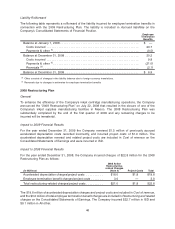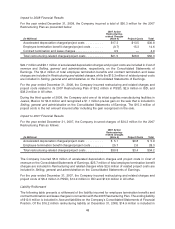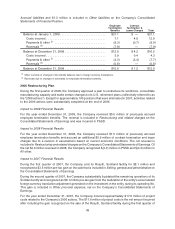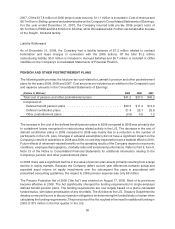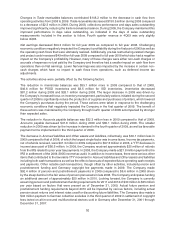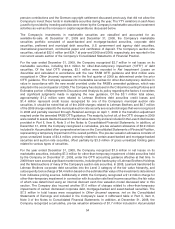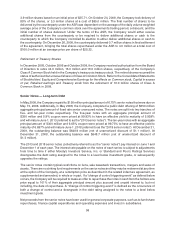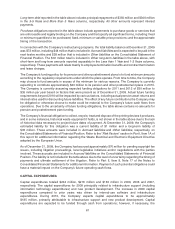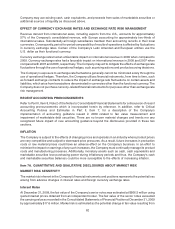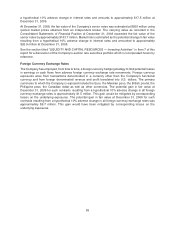Lexmark 2009 Annual Report Download - page 61
Download and view the complete annual report
Please find page 61 of the 2009 Lexmark annual report below. You can navigate through the pages in the report by either clicking on the pages listed below, or by using the keyword search tool below to find specific information within the annual report.other comprehensive loss on the Consolidated Statements of Financial Position, representing a temporary
impairment of the overall portfolio. The pre-tax valuation allowance consists of gross unrealized losses of
$8.2 million, primarily related to asset-backed and mortgage-backed securities and corporate debt
securities, offset partially by $6.5 million of gross unrealized holding gains related mostly to US
government and agency securities.
Specifically regarding the Company’s auction rate securities, as discussed in the preceding paragraph,
Lexmark has recognized OTTI on only one security due to credit events involving the issuer and the
insurer. Because of the Company’s liquidity position, it is not more likely than not that the Company will be
required to sell the auction rate securities until liquidity in the market or optional issuer redemption occurs.
The Company could also hold the securities to maturity if it chooses. Additionally, if Lexmark required
capital, the Company has available liquidity through its accounts receivable program and revolving credit
facility (new agreement in third quarter of 2009). Given these circumstances, the Company would only
have to recognize OTTI on its auction rate securities if the present value of the expected cash flows is less
than the amortized cost of the individual security. Since reclassifying to noncurrent assets the securities
that did not auction successfully at the end of the first quarter 2008, approximately $41 million of auction
rate fixed income securities have been either sold or redeemed at par. There have been no realized losses
from the sale or redemption of auction rate securities.
Fair value measurement of marketable securities
Recent events have led to an increased focus on fair value accounting, including the practices companies
utilize to value financial instruments. The Company uses multiple third parties to provide the fair values of
the marketable securities in which Lexmark is invested, though the valuation of its investments is the
responsibility of the Company. The Company has performed a reasonable level of due diligence in the way
of documenting the pricing methodologies used by the third parties as well as a limited amount of sampling
and testing of the valuations. Most of the Company’s securities are valued using a consensus price
method, whereby prices from a variety of industry data providers (multiple quotes) are input into a
distribution-curve based algorithm to determine daily market values. At December 31, 2009, pricing inputs
for securities were provided and compared to the overall valuation for reasonableness. The Company then
took a closer look at the number of pricing inputs received for each security as well as the variability in the
pricing data utilized in the overall valuation of each security. For securities in which the number of pricing
inputs used was less than expected or there was significant variability in the pricing inputs, the Company
tested that the final consensus price was within a reasonable range of fair value through corroboration with
other sources of price data. In limited instances, the Company has adjusted the fair values provided by a
third party service provider in order to better reflect the risk adjustments that market participants would
make for nonperformance and liquidity risks.
Level 3 fair value measurements are based on inputs that are unobservable and significant to the overall
valuation. Level 3 recurring fair value measurements at December 31, 2009 included auction rate
securities for which recent auctions were unsuccessful, valued at $22.0 million, as well as certain
distressed debt securities and other asset-backed and mortgage-backed securities valued at
$3.4 million. The auction rate securities were made up of student loan revenue bonds valued at
$13.7 million, municipal sewer and airport revenue bonds valued at $4.9 million, and auction preferred
stock valued at $3.4 million at year end 2009. Level 3 fair value measurements at December 31, 2008
included auction rate securities for which recent auctions were unsuccessful, valued at $24.7 million,
certain distressed debt instruments valued at $0.8 million, and other thinly traded corporate debt securities
and mortgage-backed securities valued at $0.6 million. The auction rate securities were made up of
student loan revenue bonds valued at $14.6 million, municipal sewer and airport revenue bonds valued at
$6.2 million, and auction rate preferred stock valued at $3.9 million. Level 3 recurring fair value
measurements were approximately 4% of the Company’s total available-for-sale marketable securities
portfolio at both December 31, 2009 and December 31, 2008. The valuation techniques for the Company’s
most significant Level 3 fair value measurements are discussed in the paragraphs to follow.
55



